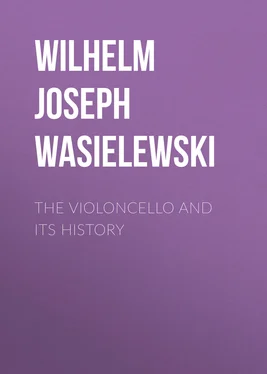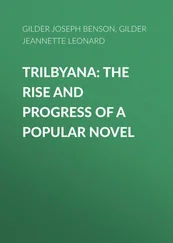Wilhelm Joseph von Wasielewski - The Violoncello and Its History
Здесь есть возможность читать онлайн «Wilhelm Joseph von Wasielewski - The Violoncello and Its History» — ознакомительный отрывок электронной книги совершенно бесплатно, а после прочтения отрывка купить полную версию. В некоторых случаях можно слушать аудио, скачать через торрент в формате fb2 и присутствует краткое содержание. Жанр: foreign_antique, foreign_home, music_dancing, на английском языке. Описание произведения, (предисловие) а так же отзывы посетителей доступны на портале библиотеки ЛибКат.
- Название:The Violoncello and Its History
- Автор:
- Жанр:
- Год:неизвестен
- ISBN:нет данных
- Рейтинг книги:3 / 5. Голосов: 1
-
Избранное:Добавить в избранное
- Отзывы:
-
Ваша оценка:
- 60
- 1
- 2
- 3
- 4
- 5
The Violoncello and Its History: краткое содержание, описание и аннотация
Предлагаем к чтению аннотацию, описание, краткое содержание или предисловие (зависит от того, что написал сам автор книги «The Violoncello and Its History»). Если вы не нашли необходимую информацию о книге — напишите в комментариях, мы постараемся отыскать её.
The Violoncello and Its History — читать онлайн ознакомительный отрывок
Ниже представлен текст книги, разбитый по страницам. Система сохранения места последней прочитанной страницы, позволяет с удобством читать онлайн бесплатно книгу «The Violoncello and Its History», без необходимости каждый раз заново искать на чём Вы остановились. Поставьте закладку, и сможете в любой момент перейти на страницу, на которой закончили чтение.
Интервал:
Закладка:
Opposed to this by its simplicity in a technical point of view is a “Sonata a Cembalo Obligato col Viol da Gamba,” by Handel. Double-stops and chords are altogether omitted. It is true that he has quite another object in view, for Handel treated the gamba not like Schenk, as a solo instrument, but as subsidiary only to carry out a musical idea, thus placing it on a level with the clavier. He chiefly uses also the middle positions of the gamba in the alto key throughout. Otherwise this Sonata, 33 33 A MS. copy exists in the Royal Library at Berlin.
though solid in form, is of small importance, and gives the impression of a composition quickly thrown off for some special occasion.
Handel’s great contemporary, Joh. Seb. Bach, treated this instrument, in his three sonatas composed for it and the clavier, in quite another manner. It is true that with rare exceptions he makes no use of the scored and harmonised technique for the gamba; but the artistic and complete mode of working out by which all his instrumental works are more or less distinguished is also peculiar to the gamba sonatas just mentioned, of which the most important are the first in G major and the third in G minor.
Charmingly and with characteristic effect did Bach employ the gamba in his Passion Music from the Gospel of St. Matthew and St. John, as well as in some of his Cantatas. One has only to recall the splendid, deeply touching alto aria “It is finished,” in the Passion Music of St. John. Now at the performance of this sublime work the gamba part in the aria referred to is played by the violoncello, which does not quite express the deeply melancholy, pathetic tone that Bach’s music was designed to express. But there is no more appropriate substitute in the modern orchestra for the gamba than the violoncello.
One peculiarity of Joh. Seb. Bach is that, with a rare knowledge of art, he made use for his purpose of all the instruments current in his time which adapted themselves in any way to the representation of a special effect. But he further conceived the idea of enriching the choir of instruments by an invention of his own. During his work at Köthen he constructed the “Viola Pomposa,” a stringed instrument of the cello kind, though, like the violin, for the hand, which had five strings tuned to C, G, d, a, ē—

Gerber remarks concerning it: “The limited way in which the violoncello in Bach’s time was handled compelled him, for the quick basses in his works, to the invention of the so-called viola pomposa, which, rather longer and higher than a tenor, had a fifth string, e, in addition to the four lower strings of the violoncello, and was placed on the arm. This convenient instrument enabled the player to execute more easily the high and rapid passages which occurred.”
It may be seen from Bach’s Suites for Violoncello Solo, which were originally written for the viola pomposa, the compass of this instrument extended from the great octave C  to the thrice-accented G
to the thrice-accented G  However, the “Viola pomposa” did not attain to general use. It scarcely survived its inventor, and disappeared, as it seems, even before the gamba, out of the musical sphere.
However, the “Viola pomposa” did not attain to general use. It scarcely survived its inventor, and disappeared, as it seems, even before the gamba, out of the musical sphere.
Bach’s eldest son, Philipp Emmanuel, also wrote for the gamba. Amongst other things a sonata in three movements, with the clavier, in G minor, 34 34 The MS. is preserved in the Royal Library at Berlin.
which was apparently composed about 1759. The three-part movement in this is solid, though somewhat meagre and dry.
Amongst the gamba compositions of the previous century, which have lasted up to our time, there is also to be noted an unpublished Concerto by Joseph Tartini, the famous founder of the old Paduan violin school, with accompaniment for four stringed instruments and two horns. 35 35 It is to be found in the autograph collection of Count Wimpfen at his estate near Gratz.
Possibly Tartini wrote it during his three years’ residence in Prague (1723-1726) for a German gambist, as about that time the gamba was still cultivated in Germany with great enthusiasm, though it had been, in Italy, thrust into the background of music by the violoncello. The Concerto bears all the marks of the author’s manner of expression, but it is in the main quite as antiquated as all his violin concertos. The introduction and Finale are in G; the “Grave” between the two movements is in D minor. The single part theme of the solo, with the exception of a few double-stoppings and chords, is throughout written in tenor and bass clef. It is worthy of remark that all the pieces are provided before the full close with cadences, written at full length, for the solo instrument, after Tartini’s usual manner in all his violin concertos.
As a contemporary of Schenk, the War Minister of Hesse-Darmstadt, Ernst Christian Hesse, who was born on the 14th April, 1676, in the Thuringian town of Grossengottern, distinguished himself. Gerber says of him, that he was the first and most famous gambist of his time in Germany. Having spent his school years at Langensalza and Eisenach, he entered the Darmstadt chancery service as supernumerary and followed the Court of his new master in 1694 to Giessen. At the Academy there he continued his work and also his legal studies. In 1698 he had permission from the Court to go to Paris in order to perfect himself there on the viol da gamba, which he had already begun to study in early life. He remained there three years and had instruction at the same time from the two famous masters, Marais and Forqueray. As privately they were at enmity with each other he was compelled to give his name to one as Hesse and to the other as Sachs. Both were delighted with his skill and progress, and severally boasted of the excellent pupil whom he had taught. At last they challenged each other to put to the test, in a concert arranged for that object, the proficiency of their pupil. But what was their astonishment on Herr Hesse’s appearance to find he was the pupil of both! He did his two masters, each in his own manner, special credit, but immediately after the occurrence left Paris.
After his return to the Darmstadt Court, in the year 1702, Hesse was named Secretary of the War Department and Foreign Office. In the following year he married.
In the year 1705 Hesse travelled through Holland and England, and two years later he betook himself to Italy, in order to increase his knowledge in the art of composition. Everywhere his gamba playing excited the greatest admiration. On his return journey from Italy he visited Vienna and was heard at Court, together with Hebenstreit, famous in his time as the inventor of a dulcimer-like instrument, called Pantaleon. The Emperor was so charmed with his playing that he presented him with a gold chain and his portrait. In the year 1713 he lost his wife. About the same period the vacant post of Kapellmeister at the Darmstadt Court was given to him ad interim . He then married his second wife, the famous singer, Johanna Eliz. Doebbrecht (Döbricht), and in 1715 he was promoted to the post of War Commissary and eleven years later to the dignity of Minister of War. “In 1719,” says Gerber, “Hesse made another musical tour with his wife to Dresden, to the famous festivals held in honour of the Elector’s marriage and where several operas by Lotti and Heinichen were represented. They both gained extraordinary honour and abundant appreciation. From this time he devoted himself quietly to the Court until his eighty-sixth year, and died May 16, 1762, after he had participated in every kind of good fortune. Besides the airs which he arranged for the church during the time that he filled the Kapellmeister’s vacancy, he left behind him many Sonatas and Suites for the Viola da gamba, which fully bring out all the possibilities of this instrument.”
Читать дальшеИнтервал:
Закладка:
Похожие книги на «The Violoncello and Its History»
Представляем Вашему вниманию похожие книги на «The Violoncello and Its History» списком для выбора. Мы отобрали схожую по названию и смыслу литературу в надежде предоставить читателям больше вариантов отыскать новые, интересные, ещё непрочитанные произведения.
Обсуждение, отзывы о книге «The Violoncello and Its History» и просто собственные мнения читателей. Оставьте ваши комментарии, напишите, что Вы думаете о произведении, его смысле или главных героях. Укажите что конкретно понравилось, а что нет, и почему Вы так считаете.












![Edward Ellis - Adrift on the Pacific - A Boys [sic] Story of the Sea and its Perils](/books/753342/edward-ellis-adrift-on-the-pacific-a-boys-sic-s-thumb.webp)